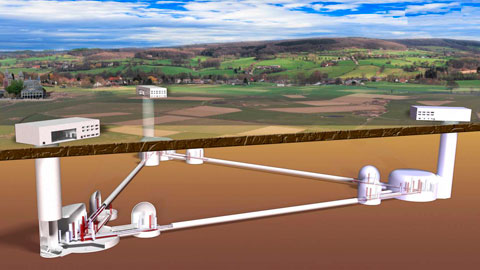The IFAE and the ICE are participating in the proposal to build a new gravitational-wave observatory

Forty European institutions, including the IFAE and the Institut de Ciències Espacials (ICE), at the UAB, have signed a proposal to include the Einstein Telescope, an ambitious third-generation gravitational-wave observatory project in the roadmap of the European program ESFRI.
The proposal to include the Einstein Telescope, a pioneering third-generation gravitational-wave (GW) observatory, in the 2021 update of the European Strategic Forum for Research Infrastructures (ESFRI) roadmap has been submitted. The ESFRI roadmap describes the future major research infrastructures in Europe. The Einstein Telescope (ET) is the most ambitious project for a future terrestrial observatory for GWs. The amazing scientific achievements of Advanced Virgo (in Europe) and Advanced LIGO (in the USA) in the last 5 years initiated the era of GW astronomy. The adventure began with the first direct detection of gravitational waves in September of 2015 and continued in August 2017 when Advanced Virgo and Advanced LIGO observed gravitational waves emitted by two coalescing neutron stars. Simultaneously signals of this event were observed with a variety of electromagnetic telescopes (on the ground and in space) over the entire observable wavelength range, from radio waves to gamma rays. This marked the beginning of the era of multi-messenger astronomy with gravitational waves.
The recent observation by Advanced Virgo and Advanced LIGO of the merging of two stellar black holes to create one 142 times more massive than the Sun (a so-called Intermediate Mass Black Hole) demonstrated the existence of such previously unknown objects in our Universe.
To fully exploit the potential of this new discipline, a new generation of observatories is needed. The Einstein Telescope will enable scientists to detect any coalescence of two intermediate-mass black holes in the entire universe and thus contribute to the understanding of its evolution. This will shed new light on the Dark Universe and will clarify the roles of dark energy and dark matter in the structure of the cosmos. ET will explore the physics of black holes in detail. These are extreme celestial bodies that are predicted by Albert Einstein's theory of general relativity, but they are also places where that theory can fail due to the extremely strong gravitational field. ET will detect thousands of coalescences of neutron stars per year improving our understanding of the behaviour of matter under such extreme conditions of density and pressure as cannot be produced in any laboratory. In addition, we will have a chance to explore the nuclear physics that controls the supernova explosions of the stars.
These challenging scientific targets need a new observatory capable of observing GWs with a sensitivity at least one order of magnitude better than the current detectors (the so-called 2nd generation). The Einstein Telescope will be located in a new infrastructure and will apply technologies that are dramatically improved over the current ones. The conceptual design of ET has been supported by a grant of the European Commission. Now a consortium of European countries and of research institutions and universities in Europe has officially submitted the proposal for the realisation of such an infrastructure with the political support of five European countries, Belgium, Poland, Spain and The Netherlands, led by Italy. The European Gravitational Observatory (EGO) in Italy constitutes its transitional headquarters. The ET consortium brings together about 40 research institutions and universities in several European countries, including also France, Germany, Hungary, Norway, Switzerland and United Kingdom. It is hoped that a companion project in the US, Cosmic Explorer, will follow.
Two sites for the realisation of the ET infrastructure are currently being evaluated: the Euregio Meuse-Rhine, at the borders of Belgium, Germany and the Netherlands, and in Sardinia, Italy. These sites are being studied and a decision about the future location of ET will be made within the next 5 years.






